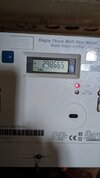- Joined
- 16 Apr 2024
- Messages
- 4
- Reaction score
- 0
- Country

We have a electric meter which has two lights on it, one showing 100A, the other 1000amp/KW hour. I have noticed this week that in the morning before 9 the 100 button is illuminated solid red. Our electric has night and day rates (the same price, we used to have economy seven and electricity board wouldn't change over to one rate only). The bottom light flashes when electricity being used, but the top button stays red even when all power breakers are off.
The red light switches off when the meter turns over to day mode at 9am.
I'm concerned as our electricity bill is horrendous, for a house using little electricity, and I'm talking about £300 per month.
Do you think we have an issue please?
The red light switches off when the meter turns over to day mode at 9am.
I'm concerned as our electricity bill is horrendous, for a house using little electricity, and I'm talking about £300 per month.
Do you think we have an issue please?

